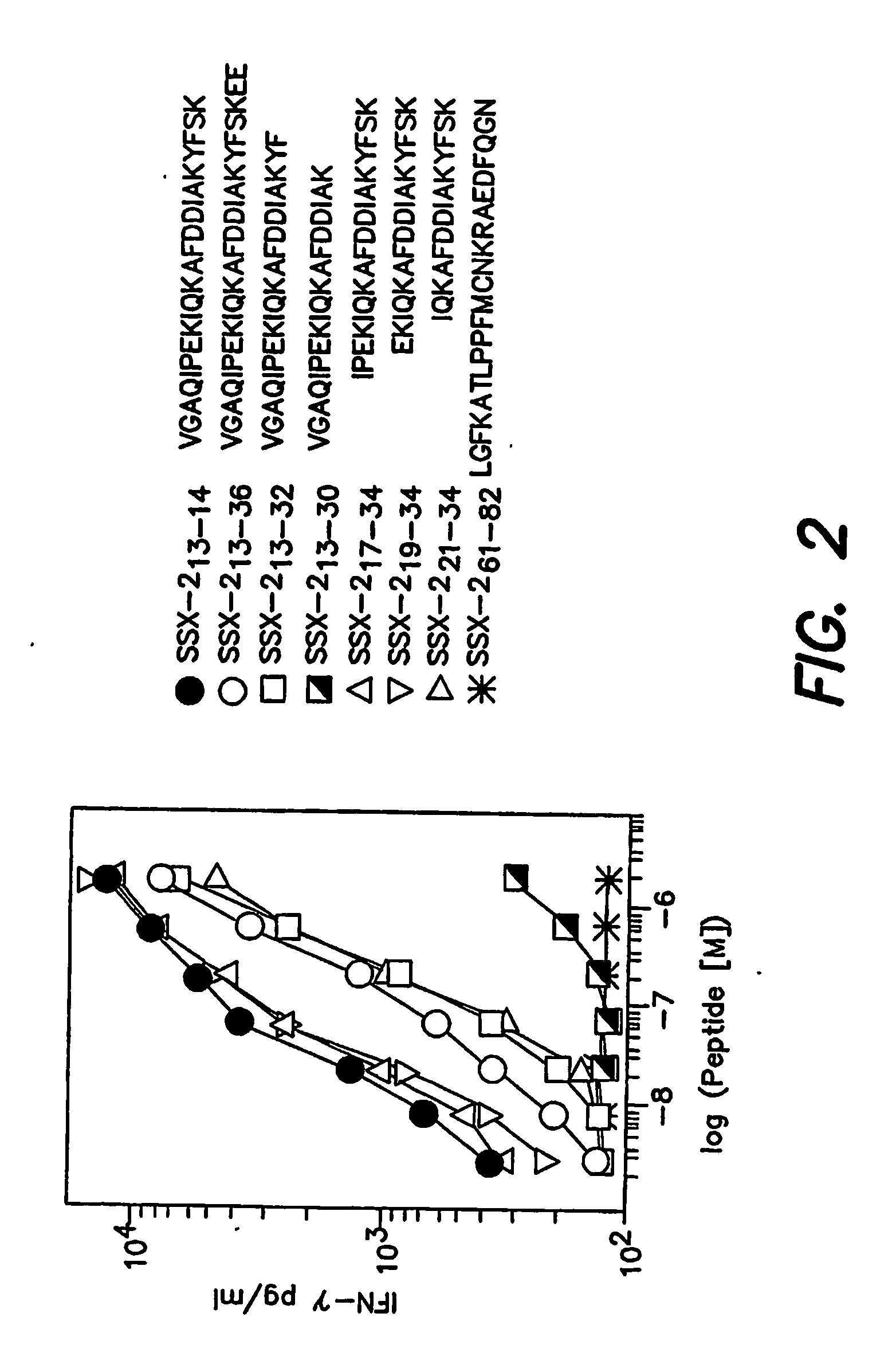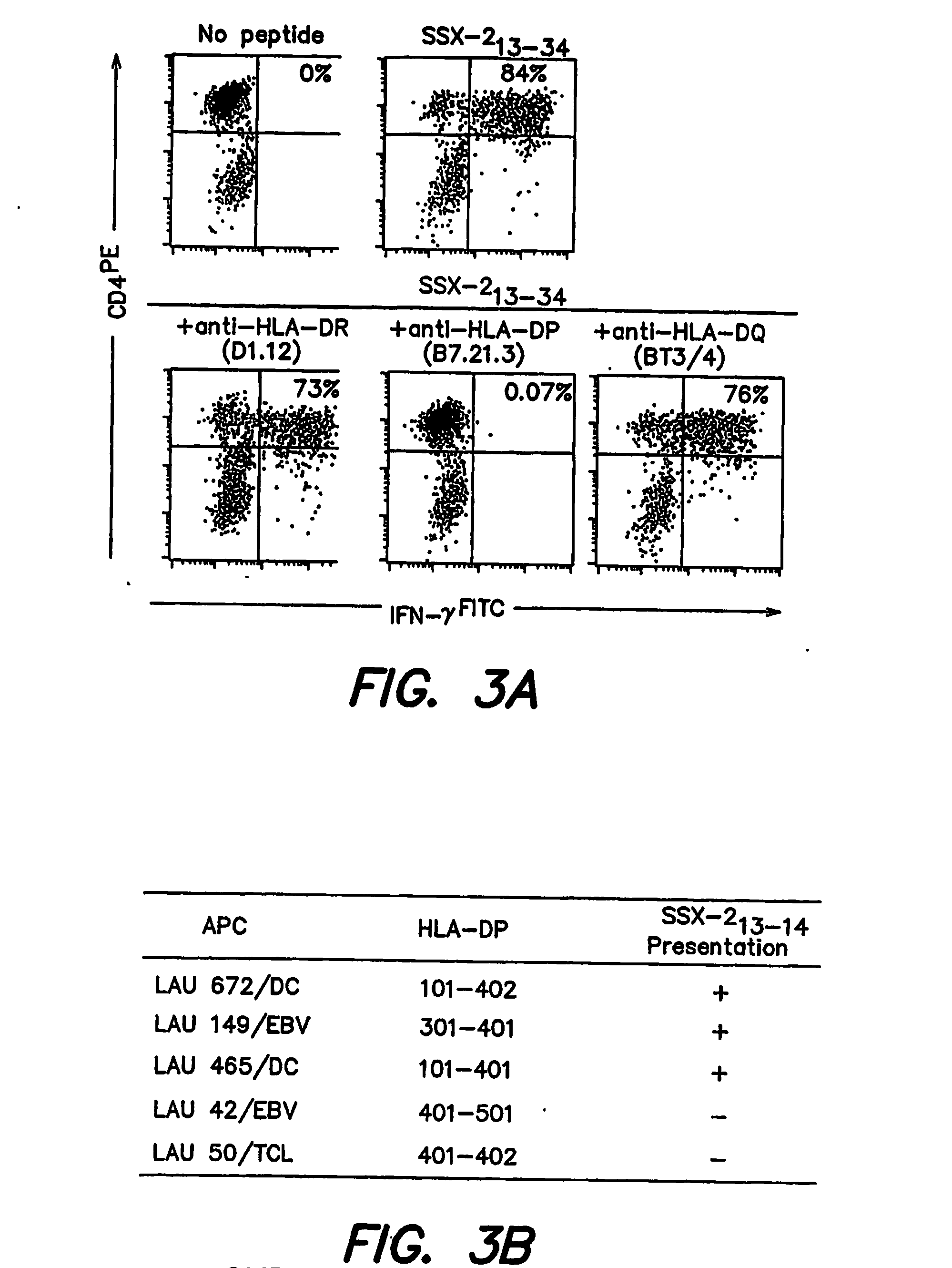Ssx-2 peptides presented by hla class II molecules
a technology of hla class ii molecules and peptides, which is applied in the field of fragments of the tumor associated gene product ssx2, can solve the problems of complex process by which the mammalian immune system recognizes and reacts to foreign or alien materials, difficult identification of mhc class ii restricted epitopes recognized by tumor antigen specific cd4sup>+/sup> t cells, and many patients who would not benefit from
- Summary
- Abstract
- Description
- Claims
- Application Information
AI Technical Summary
Benefits of technology
Problems solved by technology
Method used
Image
Examples
example 1
Assessment of SSX-2 Specific CD4+ T Cell Responses in Circulating Lymphocytes of Antigen Expressing Melanoma Patients
[0186] Enriched CD4+ T cells from PBMC samples from 5 melanoma patients with detectable SSX-2 expression in their tumor lesions were stimulated in vitro with a peptide mix containing 15 20-22 amino acid long peptides spanning the SSX-2 protein sequence and overlapping by 10 amino acids (Ayyoub M. et al, 2002, J Immunol 32:2292-2299). Two to 3 weeks after a single in vitro stimulation, culture aliquots were stimulated with submixtures, each composed of 3 peptides; P1-3 was composed of the peptides as set forth in SEQ ID NO:26, SEQ ID NO:1, SEQ ID NO:27; P4-6 was composed of the peptides as set forth in SEQ ID NO:28, SEQ ID NO:29, SEQ ID NO:30; P7-9 was composed of the peptides as set forth in SEQ ID NO:31, SEQ ID NO:32, SEQ ID NO:33; P10-12 was composed of the peptides as set forth in SEQ ID NO:34, SEQ ID NO:35, SEQ ID NO:36; and P13-15 was composed of the peptides as...
example 2
Mapping of the Minimal Peptide Optimally Recognized by SSX-2 Specific CD4+ T Cells
[0187] To more precisely define the SSX-2-derived peptide optimally recognized by specific CD4+ T cells from patient LAU 672, we analyzed the relative capacity of peptide SEQ ID NO:1 extended or truncated variants to stimulate IFN-γ secretion by specific clonal T cells (clone 2C3). As illustrated in FIG. 2, both extension and truncation of peptide SEQ ID NO:1 C-terminus resulted in decreased peptide recognition. Truncation of the first 6 amino acids at the N-terminus did not significantly affect recognition (SEQ ID NO:5 and SEQ ID NO:6). In contrast, truncation of 2 additional N-terminal amino acids resulted in a 10-fold reduction of peptide activity (SEQ ID NO:7). Thus, among analyzed peptides, SEQ ID NO:6 was the minimal peptide optimally recognized by SSX-2 specific CD4+ T cells, with SEQ ID NO:8 representing the core peptide sequence for peptides recognized by CD4+ T cells. Similar results were ob...
example 3
SSX-2 13-34 is Recognized by Specific CD4+ T Cells in the Context of HLA-DP101 and DP301
[0188] To identify the restriction element used by SSX-2 specific CD4+ T cells, recognition of peptide SSX-2 13-34 (SEQ ID NO:1) was carried out in the presence of antibodies that specifically block the recognition of antigens restricted by different MHC Class II elements (HLA-DR, HLA-DP or HLA-DQ). As illustrated in FIG. 3, anti-HLA-DP antibodies abolished the ability of SSX-2 specific CD4+ T cells to recognize peptide 13-34 (SEQ ID NO:1). In contrast, no significant inhibition was observed using anti HLA-DR or anti-HLA-DQ antibodies (FIG. 3). Under similar experimental conditions, no significant inhibition of recognition of peptide SSX-2 41-49 by specific CD8+ T cells was observed (not shown). To attempt establishing the HLA-DP presenting allele(s) we first analyzed the frequency at which PBMC from healthy donors were able to present the SSX-2 epitope to CD4+ T cells. We obtained presentation ...
PUM
 Login to View More
Login to View More Abstract
Description
Claims
Application Information
 Login to View More
Login to View More - R&D
- Intellectual Property
- Life Sciences
- Materials
- Tech Scout
- Unparalleled Data Quality
- Higher Quality Content
- 60% Fewer Hallucinations
Browse by: Latest US Patents, China's latest patents, Technical Efficacy Thesaurus, Application Domain, Technology Topic, Popular Technical Reports.
© 2025 PatSnap. All rights reserved.Legal|Privacy policy|Modern Slavery Act Transparency Statement|Sitemap|About US| Contact US: help@patsnap.com



